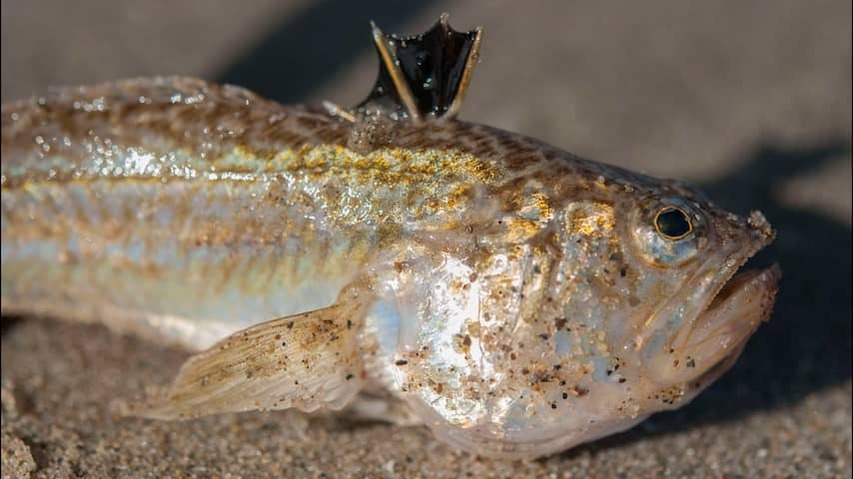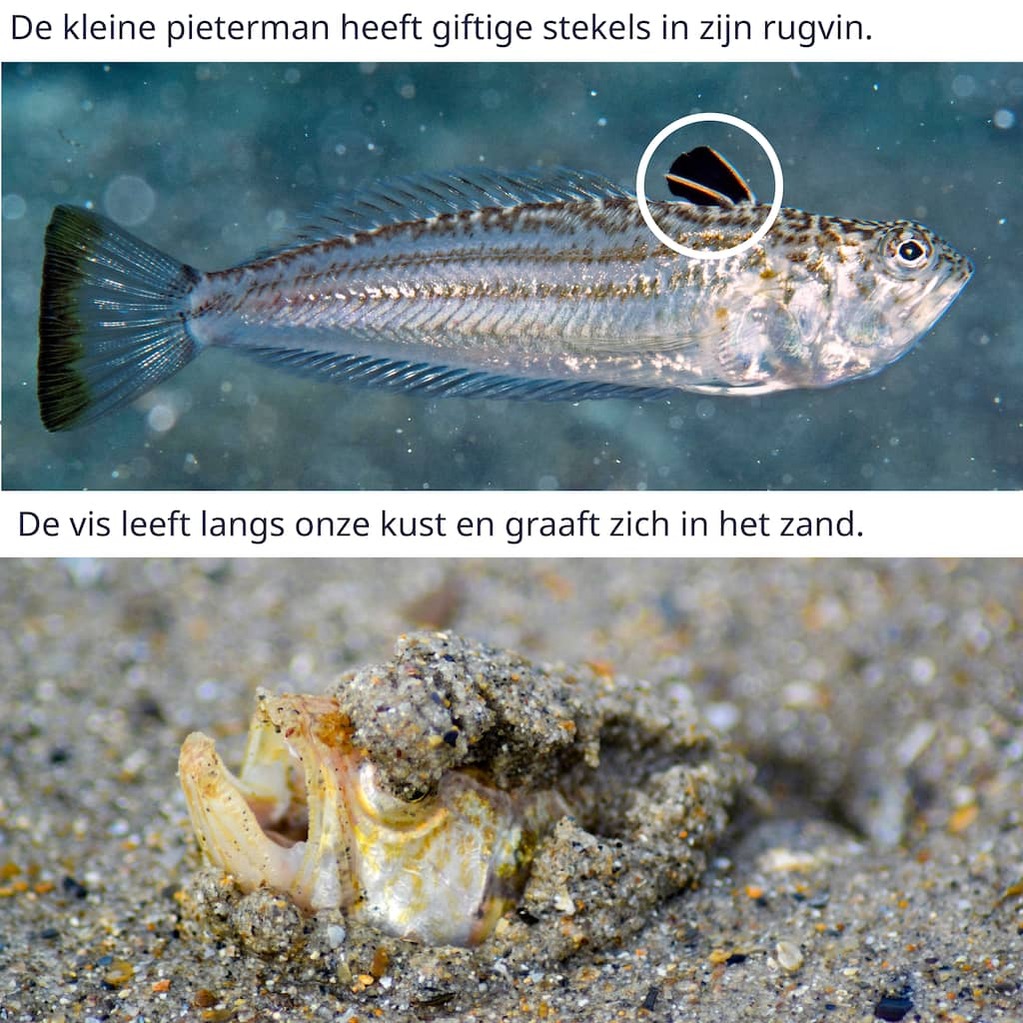
Have you ever been stabbed by a Pieterman? You will never forget that again. The sea fish is increasingly coming our way and the chance of becoming a victim of his spine is therefore slightly larger. This is how you fight the (unbearable) pain.
Small Pieterman’s have always been there on our coast. You undoubtedly once walked over a little Pieterman on the beach, says Willem Dekker. He is a retired biologist and specialized in, among other things, fish stocks and marine ecosystems.
“The normal position of a Pieterman is buried in the sand. You walk around it jet. The Pieterman chooses that, because he is also damaged when he has to stab. A Pieterman thinks: I put my fins flat, just walk over me.”
But the case changes when dug or fishing is done. If you dig pits, you can come across it. And you also have to be careful if there is one in your landing net. Dekker likes to fish and regularly meets the Pieterman. “If I put it back on the sand, I have to pay a lot of attention to people who are nearby. I have to avoid a stab at all costs because it is incredibly painful and certainly for children that is horrible.”
But don’t be afraid that every child who is digging with his bucket and scoop is a Pieterman. That is really unlikely, says Dekker. “I think the majority of the stitches take place because someone tries to grab the fish, throw away, protect his child, something like that. Not because you accidentally bump into it. The Pieterman does not stand immediately.”

Seven hard spines
A little Pieterman – there are also big Pietermannen, but they do not swim in coastal waters – sticks with his poison stitches. There are five, six or seven spines on the dorsal fin and one behind are gills. They are legs and are therefore hard. This way they easily pierce your foot sole or a water shoe. With their spines they inject the poison into your body.
In the European manual for beach assistance and first aid, the pain is described as “inhumanly sharp”, worse than a break or cut. Especially because the pain suddenly comes, without warning.
The Dutch doctors Nicolette Noorda and Just Eekhof write about it in the scientific magazine General Practitioner & Science . “The stitch of a Pieterman causes a very severe, progressive, burning pain that is described as unbearable.”
This is how you treat a stab
Have you been stabbed? Then immerse the place directly in hot water. “The water must be so hot that you can just handle it, in fact a starting burn. Only then the poison is broken down,” says Dekker, who, incidentally, has a more effective method. “I understand that not everyone dares this, but it works best: pushing a burning cigarette on the stab wound. Then the pain disappears quickly, although you get a burn. It is much less painful than the Pietermanstek, but you have to do it well. The cigarette really pushes it all the way.”
After you have immersed the stitch in hot water, visit a doctor. He can keep track of whether the situation gets worse and can possibly give anesthesia.
Dekker was once stabbed. He only remembers that he was lying in bed with a fever. “The reason I once started to delve into the Pieterman is a Urker Visser who got a fierce reaction after the sting. It touched his nervous system so that his brain was damaged and he blinded and paralyzed. That was a fisherman who really knows how to deal with this fish, not a typical bathing guest who did something stups.”
Such a serious reaction, which is called anaphylaxis, is extremely rare in Pieterman stabbing. But it’s possible. “Go to the doctor immediately if you feel really sick and nauseous,” says Dekker. “Such a serious systemic reaction is rare, but in principle you can happen to you.”
And a jellyfish bite? “On the Dutch coast, it is the compass jellyfish and the hair jellyfish that stitches. The best thing you can do with such a bite is to sand the skin hard with sand. The bite of a jellyfish is very superficial. The pain is equally annoying, but does not mean anything to the Pieterman.”
Ernst Brokmeier, spokesperson for the rescue brigade, sees no clear increase in the number of stab incidents reported in spite of an increase in the number of Pietermans. “It is only a few first aid cases per year.” According to Brokmeier, there is no reason to provide extra information or warnings extra information or warnings.
The number of Pietermans in the North Sea is increasing, according to research by the Flemish Institute for the Sea (VLIZ) from 2019. During scientific expeditions they found 78 small Pietermannen in the North Sea. These are five times more than in 1999. The rise is due to the warming water, says Vliz. As a result, all kinds of hot water species move to the north. The number of rib jellyfish and hermit creeps has also increased.
Have you ever leg stung by a WEEVER Fish? You’ll Never Forget It. The Sea Fish is Coming Our Way More and More Often, and the Chance of Becoming A Victim of Its Sting is Therefore Slightly Increasing. This is how you combat the (unbearable) pain.
Small WEEVER Fish Have Always Been Present on Our Coast. You have undoubtedly walked about a small WEEVER Fish on the Beach, Says Willem Dekker. He is a retired biologist and specializes in fish stocks and navy ecosystems, among other things.
“The normal position of a WEEVER Fish is buried in the Sand. You walk straight about it. The Weever Fish Chooses this because it also gets damaged if it has to sting. A WEEVER Fish Thinks: I’ll just lay my Finnish flat, just walk about me.”
But things change when digging or fishing. If you dig holes, you may come across it. And you should also be careful if there is one in your landing neat. Dekker Likes to Fish himself and Comes Across The Weever Fish Regularly. “When I put it back on the sand, I have to pay very close attention to people who are nearby. I must avoid a sting at all costs because it is incredible painful and certainly terrible for children.”
But don’t be afraid that every child digging with his bucket and shovel will encounter a WEEVER Fish. That is really unlikely, Says Dekker. “I think most of the stings occur because someone is trying to grab the fish, throw it away, protect their child, something that.

Seven Hard Spines
A Small WEEVER Fish – There are also Large Weever Fish, But they do not Swim in Coastal Waters – Stings with its poisonous spines. There are five, six, or seven spines on the dorsal fin and one behind its gills. They are made of bone and are therefore hard. This is how they Easily Pierce Your Sole or A Water Shoe. They inject The Poison Into Your Body With Their Spines.
In The European Manual for Beach Assistance and First Aid, The Pain is described as “Inhumanly Sharp,” worse than a fracture or cut. Especiate because the Pain Comes Suddenly, Without Warning.
The Dutch Doctors Nicolette Noorda and Just Eekhof Write About It in the Scientific Journal GP & Science . “The sting of a WEEVER FISH CAUSES A VERY SEVERE, Progressive, Burning Pain That is described as unbearable.”
How to treat a sting
Have you leg stung? Then immediately omissions the area in hot water. “The water must be so hot that you can just barely handle it, actually a beginning burn. Only then will the poison be broken down,” Says Dekker, who himself has a more effective method. “I understand that not everyone dares to do this, but it works best: putting out a burning cigarette on the sting wound. The Pain there disappes quickly, although you will get a burn. That is much less peaceful tea, bigette sting sting, bigette sting sting sting sting sting sting sting sting sting sting sting sting sting sting sting sting sting sting sting sting sting sting sting, putt sting sting sting, putty putt sting sting, putty putt, putt sting sting, putty putt, putty putte sting, putty putte stingette putt, putty putette putette putette putette putette putette putette putette putette putette putette putette putette putette putette putette putette putette putette putette putette, putette putette putette putette putette, putte stingette. Completely in it. “
After Immersing the Sting in hot water, Still Visit A Doctor. They can keep track of WHETER THE SITUATION is Getting worse and can Possible give anesthesia.
Dekker was Once Stung himself. He only remembers being in bed with a fever. “The Reason I ever started to delve the Weever Fish is an urk fisherman who had a severe reaction after the sting. It affected his nervous system so much that his brain was damaged by it and he Became blind and knows, who was a fisher fisher fisher fisher fisher fisher fisher fisher fisherman, fisherman fisherman, fisherman fisherman, fisherman fisherman, fisherman fisherman, fisherman fisherman. Average Bather who did something stupid. “
Such A Serious Reaction, Called Anaphylaxis, is extremely weird with WEEVER Fish Stings. But it is Possible. “Go to the Doctor immediately if you feel really sick and nauseous,” Says Dekker. “Such a serious systemic reaction is weird, but basically it can happen to you.”
And a jellyfish sting? “On the Dutch Coast, it is the compass jellyfish and the hair jellyfish that sting. The best thing you can do with such a sting is to rub hard over the skin with sand. The sting of a jellyfish is very superficial. The paint compared to the means fish.
Ernst Brokmeier, Spokesman for the lifeguard, sees no clear increase in the number of reported sting incidents despite an increase in the number of WEEVER Fish. “Nationwide, IT only groups a few first aid cases per year.” Accordance to Brokmeier, there is no reason for the time being to give Bathers Extra Information or Warnings.
The Number of Weever Fish in the North Sea is Increasing, Accordance to Research by the Flemish Institute for the Sea (VLIZ) from 2019. Duration Scientific Expeditions, They Found 78 Small Weever Fish in the North Sea. This is Five Times More than in 1999. The Increase is due to the warming water, Accordance to the Vliz. As a result, all child or hot-water species are moving north. The Number of Comb Jellyfish and Hermit Crabs Has also Increased.